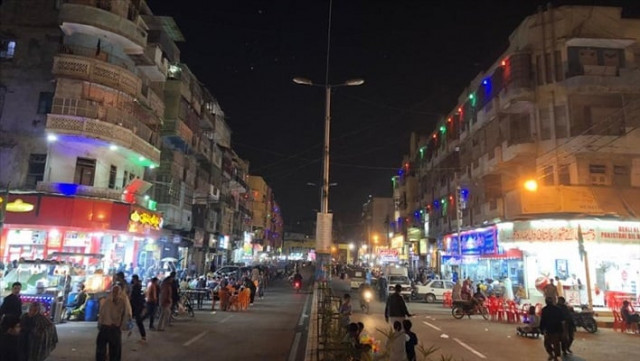Pedestrianised Burns Road in Karachi brings back foodies
Vehicles banned from entry in evenings at iconic food street since Jan 10

Scores of families have gathered at Burns Road, a century-old food hub in Karachi, to grab a taste of traditional Pakistani cuisine.
While some are waiting for their sajji, chicken or lamb marinated in simple spices, attached to skewers and roasted over coals, others are hunched on plastic chairs outside restaurants enjoying items such as biryani (rice and meat), nihari (meat stew) and kebabs.
Many are also having their after-meal desserts such as gulab jamun (sweet balls), rabri (milk-based sweet), and ice cream.
The downtown street had long been a food hub for Karachiites, Pakistanis all over and even foreigners.
Traffic congestion, decaying structures and a deteriorating law and order situation, however, diverted the loyal clientele to other parts of the sprawling cosmopolitan, home to more than 20 million people.
But a recent restoration and renovation of the 200-meter (656-foot) two-way street have brought back the "lost glory."
While the crumbling structures have been repaired and repainted, vehicles have been banned to enter the site after 7 pm local time since Jan 10.
Visitors now park vehicles at dedicated parking spaces, and only area residents and shopkeepers are allowed to bring in their automobiles.
"I'm here after years. It looks completely different," Mohammad Malik, a visitor, told Anadolu Agency as his wife and children devoured fried kebab at Waheed Kabab House. "It's clean, safe and attractive. You can freely walk on either side of the road without any fear," he said, referring to the law and order situation in the port city, which has significantly improved in recent years.
"Pizza, burgers, and other fast food items may be the in thing nowadays but [traditional] desi food is insatiable," said Waqas Ali, a final-year engineering student. "Safe, clean and colorful atmosphere, sumptuous food, and a balmy night... what else do you want?"
Return of business
"This transformation has given a fresh lease on life to my business," said Iqbal Waheed, whose father, Abdul Waheed, established this restaurant in 1961.
Waheed has also renovated his restaurant, now with a proper dine-in arrangement for families as well. "We have made it better, which has brought back the customers," he said.
Mohammad Khalid, who works at Delhi Rabri House, shared a similar view. "The number of customers has increased thanks to a conducive environment," he said as buyers lined up at different glass counters.
"There is no noise or smoke from buses, taxis and rickshaws. Only revelers and food," he said.
History
City historians say the street derives its name from a British doctor, James Burnes, who served the colonial regime in the first half of the 19th century in the southern Sindh province, of which Karachi is the capital.
According to Arif Hassan, an architect and city planner, Burns Road was planned in 1870, and it initially served as an artillery training and practice center for the British Army.
"Burns Road earned the reputation of a food hub after the partition of India in 1947 when around 80,000 Delhiwalas [people from the Indian capital Delhi] migrated to Karachi and settled in this area,” Hassan told Anadolu Agency.
Following communal riots in 1948, he said, Hindus left for India, leaving space for Delhiwalas, who then introduced Indian varieties, including haleem (blend of spices, meat, barley and wheat) and paan (betel leaf with areca nut).
Before the rise of Burns Road, the adjacent Ram Bagh (now Aram Bagh) was Karachi's key meeting point, he added.



















COMMENTS
Comments are moderated and generally will be posted if they are on-topic and not abusive.
For more information, please see our Comments FAQ